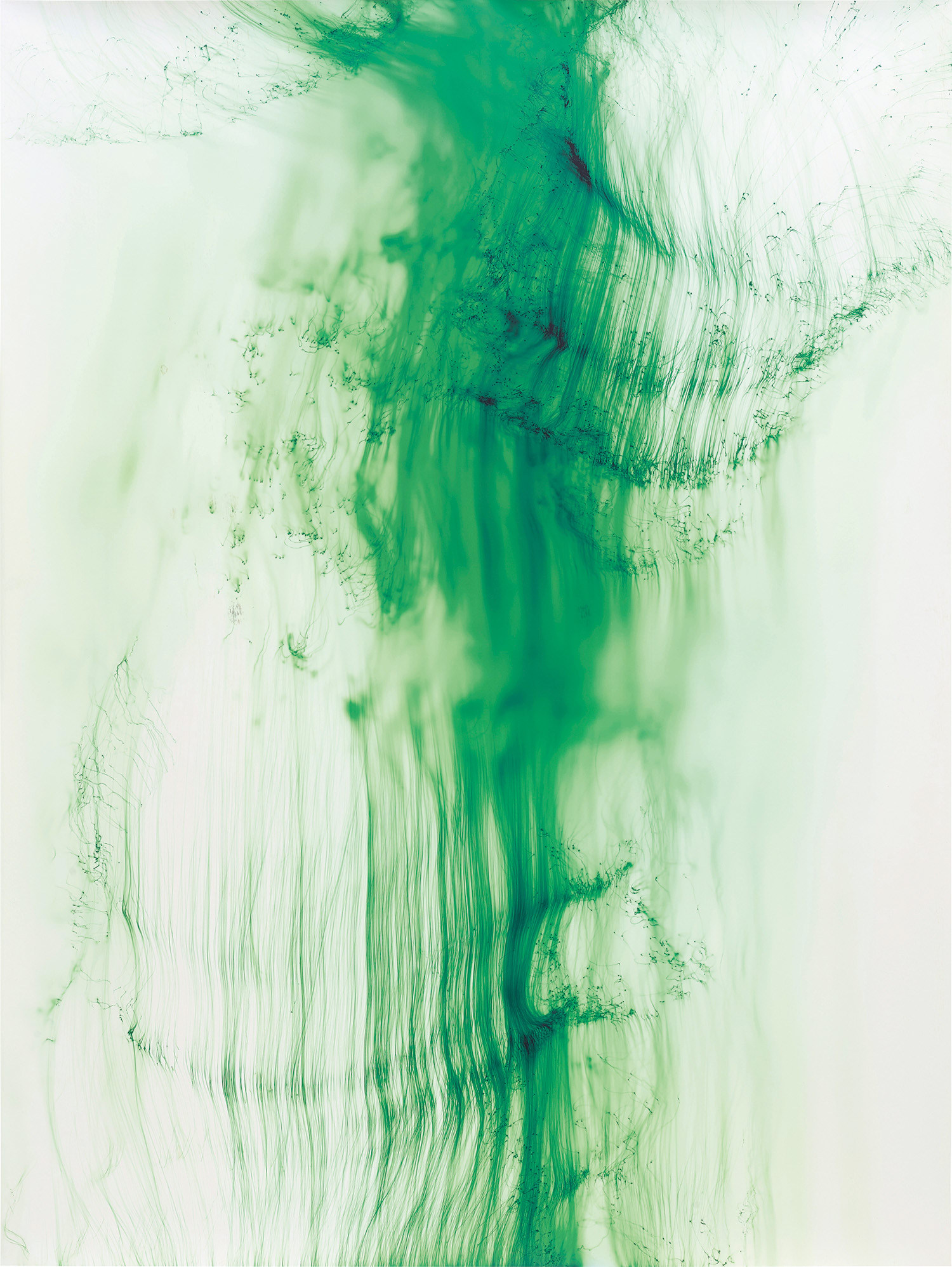

161
Wolfgang Tillmans
Freischwimmer 34
Full-Cataloguing
Fragile threads of spun emerald surge and swell in Wolfgang Tillmans’ Freischwimmer 34, an early example from the artist’s pivotal Freischwimmer series. Conceived a year after the artist’s first retrospective at Tate Britain in 2003, Freischwimmer 34 is exemplary of Tillmans’ enquiry into the possibilities of abstraction in photography. This pivotal series is integral when looking at the artist’s wider oeuvre and showcases Tillmans’ adroit ability to manipulate photographic techniques to produce sublime and poetic planes of light and colour. This celebrated body of work has been represented internationally at the artist’s recent retrospective, Wolfgang Tillmans: 17, at Tate, London, which later travelled to Fondation Beyeler in Riehen.
Produced during the early 2000s, the Freischwimmer series, Tillmans explains, was made by his manual manipulation of ‘light-sources and light-emitting tools’ over light-sensitive paper in the darkroom (‘Excerpts from Interviews, Lectures, and Notes’, in Wolfgang Tillmans, Abstract Pictures, Ostfildern, 2015, p. 25). Translating literally as ‘free swimmer’, Tillmans’ title provides a poetic edge to the entire series, denoting the name of a child’s badge, bestowed to signify the passing of a swimming test. Aptly, the phrase also holds a figurative meaning: learning to stand on one’s own two feet. The image’s subtext of liberation is evoked in Tillmans’ use of laser-light to generate the surface pattern, as the artist relinquishes control and allows light to imprint spontaneously upon the paper’s surface.
In Freischwimmer 34, Tillmans toys with the physical presentation of his ambiguous work by opting to hang his inkjet print on bulldog clips, subverting traditional notions of pictorial presentation and transporting us to the artist’s studio or dark room. Traversing between abstraction and figuration, his execution allows us to interpret the surging form in the present work, but denies us explicit access to figuratively represented objects and relationships. Tillmans aims to ‘disturb’ the traditional use of photography, as a documentation of reality, and to expose ‘an object in space’. Instead the artist presents us with a mixture of paper and dye and an image of mechanics and processing. We also find within his images traces of Tillmans’ own childhood fascination with astronomy which added to the artist’s development and ‘visual understanding’ (‘Excerpts from Interviews, Lectures, and Notes’, in Wolfgang Tillmans, Abstract Pictures, Ostfildern, 2015, p. 24); the present work is evocative of a telescope’s visual rendering of the sun’s swirling photosphere. Tillmans has compared his technique of ‘light painting’ to that of the Romantic British landscape artist, J.M.W. Turner, in that Turner captured light and translated it into matter, as scumbled, encrusted marks of thick paint, whereas Tillmans presents light as palpable, vigorous and present (National Museums Liverpool, Walker Art Gallery, Wolfgang Tillmans: At the Walker Art Gallery Liverpool, 18 September – 12 December 2010, online).
Rising to prominence in the early 1990’s, capturing scenes of seeming everyday life from couples embracing, to sliced fruit, composed still-lives of shells, to intimate, half-naked portraits, Tillmans’ provocative work has garnered international critical acclaim. As the art critic Adrian Searle notes, ‘Tillmans asks us to make connections of all kinds’ (Adrian Searle, ‘Wolfgang Tillmans review – a rollercoaster ride around the world’, The Guardian, 14 February 2017, online). With his multiplicity of subjects, incongruous themes and ability to transport photographic process to the forefront of his composition, Tillmans celebrates the boundless possibilities in the medium of photography through the arabesques and vital energy coursing through Freischwimmer 34.
Wolfgang Tillmans
German | 1968Since the early 1990s, Wolfgang Tillmans has pushed the boundaries of the photographic medium. Challenging the indexical nature traditionally associated with photography, his abstract and representational photographic bodies of work each in their own way put forward the notion of the photograph as object—rather than as a record of reality. While achieving his breakthrough with portraits and lifestyle photographs, documenting celebrity culture as well as LGBTQ communities and club culture, since the turn of the millennium the German photographer has notably created abstract work such as the Freischwimmer series, which is made in the darkroom without a camera.
Seamlessly integrating genres, subject matters, techniques and exhibition strategies, Tillmans is known for photographs that pair playfulness and intimacy with a persistent questioning of dominant value and hierarchy structures of our image-saturated world. In 2000, Tillmans was the first photographer to receive the prestigious Turner Prize.